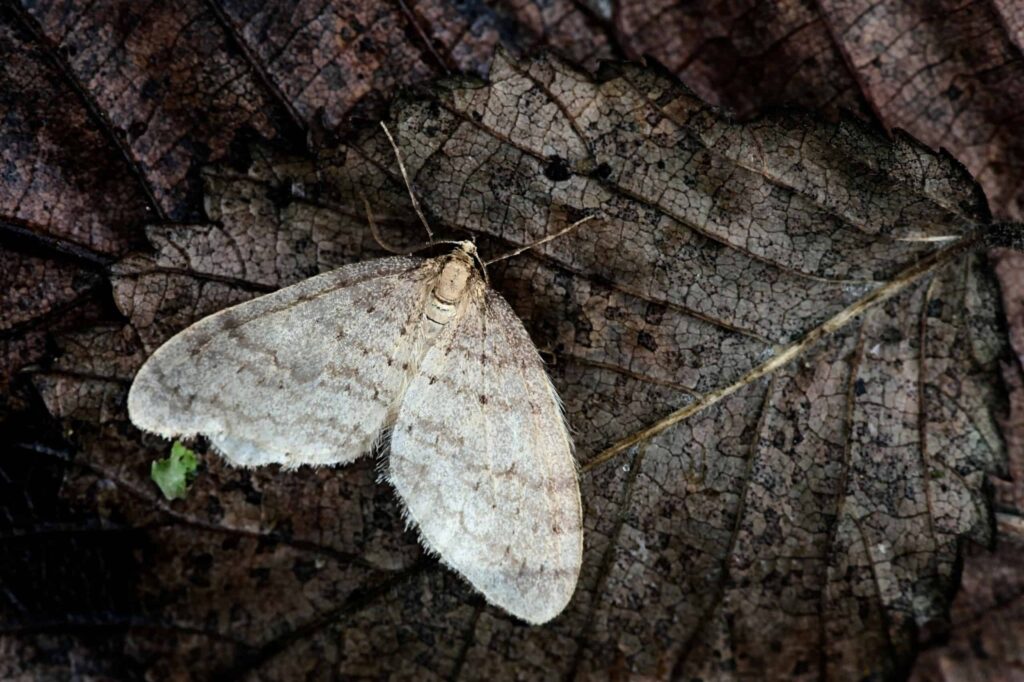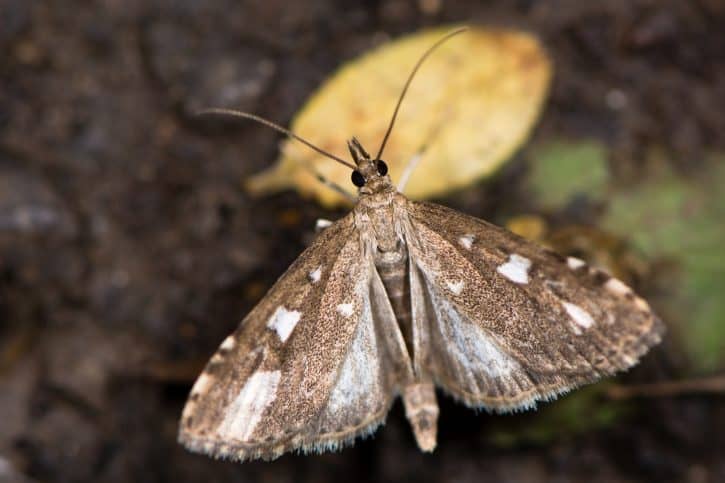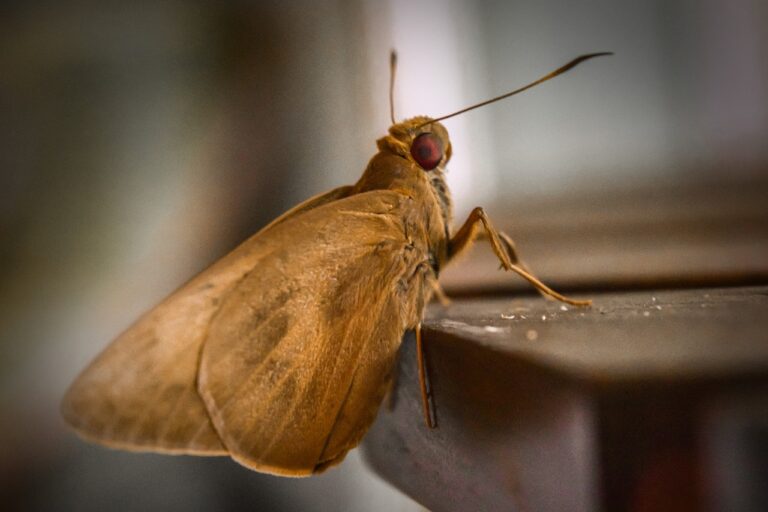Getting rid of moths in your garage can be accomplished through a combination of preventive measures and targeted interventions. Here are quick steps to help you eliminate moths from your garage:
- Identify the type of moths for targeted control.
- Clean and declutter the garage to remove hiding spots.
- Seal entry points to prevent moths from getting inside.
- Install screens on windows and vents.
- Store items like clothing and food in airtight containers.
- Use moth repellents or sachets with cedar or lavender.
- Consider pheromone traps for clothes moths.
- Employ natural predators like parasitic wasps if possible.
- Use insecticides as a last resort, following instructions.
- Regularly monitor for moths and larvae.
- Consult a pest control professional if needed.
How to identify the type of moths in the garage?

When dealing with a moth infestation in your garage, it’s crucial to identify the specific type of moths you’re dealing with.
Different species of moths have different habits and preferences, and understanding their characteristics can help you choose the most effective control methods. Here are some steps for identifying the type of moths:
Visual Inspection: Begin by conducting a visual inspection of the moths you encounter in your garage. Pay attention to their size, color, and wing patterns. This can provide initial clues about their species.
Behavioral Patterns: Observe their behavior. Are they attracted to clothing and fabrics, or are they more interested in stored food items? This can help differentiate between clothes moths and pantry moths, two common types found in garages.
Larvae Identification: If possible, look for moth larvae or caterpillars. Their appearance, size, and color can be distinctive and provide further clues about the moth species.
Online Resources: Use online resources, field guides, or pest identification websites to compare the moths you’ve found with known species. You can also consult with local entomologists or pest control professionals for expert guidance.
Pheromone Traps: If you suspect clothes moths, consider setting up pheromone traps designed for them. These traps can help confirm the presence of clothes moths and indicate their population size.
Assessing the Extent of the Infestation:
After identifying the type of moths in your garage, the next step is to assess the extent of the infestation.
This evaluation helps determine the severity of the problem and guides your control efforts. Here’s how to assess the infestation:
Visual Inspection: Conduct a thorough visual inspection of the garage. Look for signs of moths, including adult moths, larvae, pupae, and cocoons. Pay special attention to areas where moths may hide or lay eggs, such as dark corners, stored items, and cracks in walls.
Damage Assessment: Examine stored clothing, fabrics, and food items for any signs of damage caused by moth larvae. Clothes moths, for example, leave behind irregular holes in fabrics, while pantry moths may contaminate food with webbing and feces.
Monitoring Traps: If you’ve set up pheromone traps, check them regularly to gauge the moth population. An increasing number of trapped moths may indicate a growing infestation.
Interview and Observation: Talk to other household members or individuals who frequently access the garage. They may provide valuable information about moth sightings and activity.
Record Keeping: Maintain a record of your observations, including dates, locations of moth sightings, and any damage caused. This documentation can help track the progress of your control efforts.
How to properly store items to prevent moth infestations?
Cleaning and decluttering your garage is an essential first step in moth control. It eliminates hiding spots and food sources, making the environment less hospitable for moths. Here’s a deeper understanding of this preventive measure:
Thorough Cleaning: Start by thoroughly cleaning all surfaces in the garage, including floors, walls, shelves, and storage containers. Use a vacuum cleaner to remove dust, debris, and any potential food crumbs.
Remove Clutter: Declutter the garage by getting rid of items you no longer need. Moths are drawn to dark, undisturbed areas where they can lay eggs and hide. Removing unnecessary items reduces hiding spots.
Pay Attention to Fabrics: Pay special attention to fabric-based items in the garage, such as clothing, upholstery, and rugs. These are potential targets for clothes moths. Ensure they are clean and stored properly.
Regular Maintenance: Maintain a routine cleaning schedule for your garage to prevent future infestations. Regular cleaning will also help you spot moth activity early on.
Sealing Entry Points:
Preventing moths from entering your garage in the first place is a proactive approach to control. Here’s how to seal entry points effectively:
Inspect for Gaps: Conduct a thorough inspection of the garage’s walls, doors, windows, and roof. Look for any gaps, cracks, or holes that moths could use as entry points.
Seal Cracks and Gaps: Use appropriate materials like caulk, weatherstripping, or sealant to seal any gaps and cracks you find. Pay particular attention to areas around doors and windows.
Replace Damaged Screens: If your garage has windows or vents, ensure that screens are intact and free of holes. Repair or replace damaged screens to keep moths out.
Installing Screens on Windows and Vents:
Installing screens on windows and vents is an effective way to prevent moths from entering while allowing ventilation. Here’s a closer look:
Choose Appropriate Screens: Select screens with a mesh size fine enough to keep moths out. Fine-mesh screens are also effective at blocking other insects.
Proper Installation: Ensure screens are securely fastened and properly fitted to windows and vents. Check for any gaps or loose edges that could allow moths to bypass the screen.
Proper Storage of Items:
Proper storage practices are crucial to prevent moths from infesting your belongings. Here’s how to store items in a way that discourages moths:
Airtight Containers: Store clothing, fabrics, and food items in airtight containers or sealed plastic bags. This prevents moths from accessing their food sources and breeding grounds.
Elevate Items: Keep stored items off the floor and away from walls. Moths are more likely to infest items that are in direct contact with surfaces.
Using Moth Repellents or Sachets:
Moth repellents and sachets containing natural substances can deter moths from settling in your garage. Here’s a deeper understanding:
Natural Repellents: Cedarwood, lavender, cloves, and other natural substances are known to repel moths. Place sachets or cedar blocks in strategic locations in the garage.
Replacement and Renewal: These repellents lose their potency over time. Replace or refresh them as needed to maintain their effectiveness.
Considering Natural Predators:
Introducing natural predators of moths into your garage can be an eco-friendly way to control infestations. Here’s what to consider:
Beneficial Insects: Parasitic wasps and predatory beetles are known to feed on moth larvae. You can introduce these insects into your garage if they are native to your region.
Maintain a Balanced Ecosystem: Ensure your garage environment supports these natural predators by minimizing pesticide use and providing suitable habitats.
Research and Consultation: Consult with local entomologists or pest control professionals to determine if introducing natural predators is a viable option for your specific moth problem.
How to use pheromone traps for clothes moths?

Pheromone traps are a targeted and environmentally friendly method for controlling clothes moths. They work by using synthetic pheromones to attract male moths, disrupting their mating cycle. Here’s a deeper understanding of this intervention:
How Pheromone Traps Work: Pheromones are chemical signals that insects use for communication. Female clothes moths release pheromones to attract males for mating. Pheromone traps mimic these chemical signals, luring male moths into the trap.
Monitoring and Trapping: Pheromone traps serve a dual purpose: monitoring and trapping. They help you assess the severity of the clothes moth infestation by capturing male moths. Regularly inspect the traps for trapped moths to gauge the population size.
Disruption of Reproduction: By capturing male moths, pheromone traps disrupt the reproductive cycle of clothes moths. This reduces the number of eggs laid and decreases the population over time.
Placement: Position the traps strategically in areas with the most moth activity. Typically, this includes closets, storage areas, and other spots where clothing or fabrics are stored. Follow the manufacturer’s instructions for proper placement.
Patience is Key: Pheromone traps may not provide immediate results. It can take several weeks to months to see a significant reduction in the moth population. Continue using them consistently for effective control.
Safe Use of Insecticides as a Last Resort:
Insecticides should be considered a last resort when dealing with a persistent moth infestation. They can be effective but should be used with caution, especially in areas where people or pets frequent. Here’s a deeper understanding of using insecticides:
Choose the Right Product: Select an insecticide specifically formulated for moths and labeled for indoor use. Read the label carefully to ensure it’s safe for the intended application.
Follow Instructions: Strictly adhere to the manufacturer’s instructions regarding dosage, application method, and safety precautions. Failure to do so can result in ineffective treatment or health hazards.
Targeted Application: Apply insecticide directly to areas with moth activity, such as cracks and crevices, corners, and areas where moths have been spotted. Avoid spraying large areas unnecessarily.
Safety Measures: When using insecticides, take appropriate safety measures. Wear protective clothing, including gloves and a mask, and ensure good ventilation in the treated area.
Keep Out of Reach: Store insecticides out of the reach of children and pets. Follow disposal instructions for empty containers to minimize environmental impact.
Monitor and Reapply: Insecticides may require multiple applications to be effective. Monitor the garage for any resurgence of moth activity and reapply as needed, following label recommendations for reapplication intervals.
Consider Professional Help: If you are uncomfortable using insecticides or if the infestation is severe and persistent, consider hiring a licensed pest control professional. They have the expertise and access to professional-grade products to address the issue safely and effectively.
How to effectively monitor for signs of moths and larvae in the garage?
Maintaining a clean garage is essential for preventing moth infestations and ensuring that any remaining moths or eggs are not given a chance to thrive. Here’s a deeper understanding of regular cleaning routines:
Scheduled Cleaning: Establish a routine cleaning schedule for your garage. How often you clean will depend on your specific circumstances, but a quarterly or semi-annual cleaning is often sufficient for most homeowners.
Thorough Cleaning: During cleaning sessions, pay attention to all surfaces, including floors, walls, and shelves. Vacuum corners and crevices to remove dust and debris where moths might hide.
Fabric and Clothing Inspection: Regularly inspect stored clothing, upholstery, and fabrics for signs of moth activity. Look for holes, damage, or larvae. If you detect any issues, take appropriate action to address them promptly.
Decluttering: As part of your cleaning routine, continue to declutter your garage. Remove items you no longer need or use, as clutter can provide hiding spots for moths.
Cleaning Supplies: Use appropriate cleaning supplies, such as a vacuum cleaner with a HEPA filter to capture small particles, and eco-friendly cleaning solutions to avoid chemical residues.
Monitoring for Signs of Moths and Larvae:
Regular monitoring is essential to detect any resurgence of moths or larvae in your garage. Here’s a deeper understanding of how to monitor for signs of moths and larvae:
Visual Inspection: Periodically inspect your garage for signs of adult moths, larvae, pupae, or cocoons. Pay attention to areas where moths are likely to hide, such as corners, cracks, and stored items.
Traps and Pheromone Devices: If you’ve set up pheromone traps or sticky moth traps, check them regularly. An increase in trapped moths may indicate a resurgence or ongoing infestation.
Damage Assessment: Inspect any stored clothing, fabrics, or food items for signs of damage. Clothes moths, for example, create irregular holes in fabrics, while pantry moths may leave behind webbing or feces.
Documentation: Maintain records of your monitoring efforts. Note the dates of inspections, locations of moth sightings, and any damage observed. This documentation helps you track the effectiveness of your preventive measures.
Early Intervention: If you notice any signs of moths or larvae during your monitoring activities, take immediate action to address the issue. Isolate infested items, clean the affected area, and consider additional pest control measures if necessary.
Regularity: Monitoring should be an ongoing process, even after you believe the moth infestation has been successfully controlled. Moths can return, and early detection is key to preventing a full-blown infestation.
FAQ’s
What kills moths permanently?
Eliminating the source of attraction (food, fabrics), maintaining a clean environment, and using pheromone traps can help control and potentially eliminate moths.
What scent keeps moths away?
Moths dislike scents such as cedar, lavender, cloves, and mint. These natural fragrances can help deter moths from settling in an area.
How do you kill moths ASAP?
To quickly address a moth problem, use a vacuum cleaner to remove visible moths and larvae, then implement preventive measures like proper storage and cleaning routines.
Does vinegar kill house moths?
While vinegar can repel moths due to its strong odor, it is not a direct insecticide and may not effectively kill moths.
What is a natural killer for moths?
Natural killers for moths include beneficial insects like parasitic wasps and predatory beetles, as well as pheromone traps specifically designed to disrupt their mating cycle.
Do moths hate vinegar?
Yes, moths are repelled by the strong odor of vinegar, making it a natural deterrent.
Final Word
In conclusion, effectively getting rid of moths in your garage requires a multi-faceted approach that combines preventive measures, targeted interventions, and ongoing maintenance.
By identifying the type of moths, assessing the extent of the infestation, and implementing prevention strategies such as cleaning, sealing entry points, and proper storage, you can create an inhospitable environment for moths.
Using pheromone traps and, as a last resort, insecticides can further aid in moth control. Regular maintenance routines and vigilant monitoring help ensure long-term success by preventing future infestations and detecting any signs of moths or larvae early on.
Remember that persistence is key in the battle against moths, and a well-rounded strategy will help you maintain a moth-free garage and protect your belongings.

